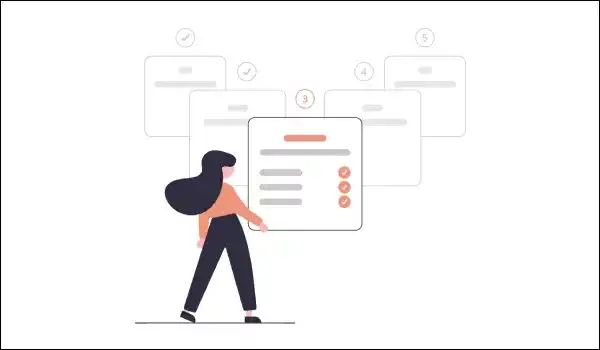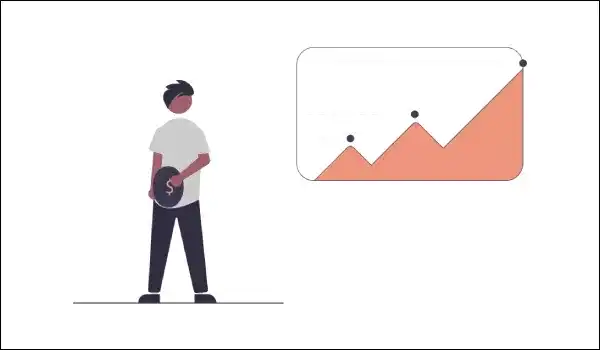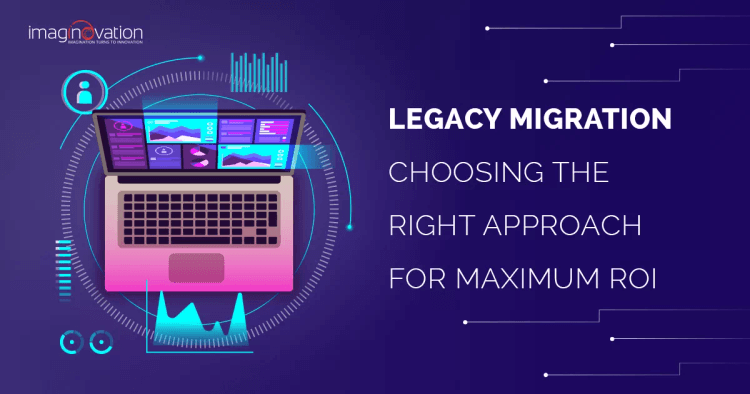Haven’t we always been told – “Old is gold”?
Well, that’s not always the case, especially when it comes to legacy IT applications.
They don’t get better with age.
On the contrary, these aging IT systems gradually become outdated, obsolete, and redundant.
Because of outdated technology, legacy applications are bound to face problems related to user experience, integration, maintenance, support, and business productivity.
The good thing is that we can solve all these challenges with legacy migration by modernizing aging applications.
However, it’s important to choose the right legacy migration approach for successful modernization.
In this guide, we will look at the important steps that can help you choose the right legacy modernization approach for your business.
How to Prepare for Legacy Migration?

Before you start with the legacy migration process, you need to ensure that your business objectives are clear and that you and your IT team are on the same page.
Here’s how to prepare for a seamless migration process.
1. Understand and Define Your Goals
The first step in preparing your business for migration is to understand your goals. You need to link your modernization efforts to your company’s business and tech goals and build consensus around them.
Find answers to your why – why is migration crucial for your business?
For example, if you are trying to build a new customer communications strategy by migrating your legacy IT applications, find answers to why you are doing it.
Are you trying to fix a compliance issue? Are you looking for core system modernization? Is the new system needed to reduce risk or centralize business communication?
So, the key is to understand the cause of your problem – is it technology, architecture, or application functionality? And then decide how the modernization approach will improve these aspects.
Identify how legacy system modernization will impact your company’s revenue, market share, and customer experience.
Remember, gaining consensus on the why is a crucial but sometimes overlooked aspect of this digital transformation.
The primary goals will help you develop the KPIs (key performance indicators) and other metrics to quantify its success.
2. Select the Right Cloud Deployment Option
Organizations around the world are adopting a cloud-first strategy. Cloud computing can help you scale up to support larger workloads and manage users far more easily than on-premises infrastructure.
So, what options do you have when it comes to choosing the right cloud strategy for your business? Check out the options below.
- Hybrid Cloud
A hybrid cloud can be a mix of two or more types of environments. It can combine public clouds, private clouds, or on-premises legacy data centers.
Tight integration across all deployed clouds is a must for this approach to work well.
- Multi-Cloud
Multi-cloud deployment is done by combining two or more public clouds. Public clouds are the ones that are shared by more than one customer.
It offers multiple benefits, including cost savings, easy backup, or leveraging features from different cloud providers.
- Single Cloud
Deploying a single cloud from just one cloud vendor is not always feasible for a business, but it is an option.
You can choose either a public cloud or a private cloud. Private clouds are not shared with any other business.
3. Assess Your Company’s Digital Readiness
The leap to a modern cloud-based service can only happen when your company is ready to make that move.
Therefore, ensuring your company’s digital readiness is the most critical step.
Map out your company’s existing infrastructure and conduct a gap analysis to check how digitally ready your company is. This will give you a clear picture of the steps you need to take to make your organization ready for digitalization.
4. Estimate the Cost of Migration
Once you’re ready, you need to find a reliable vendor and get estimates on the migration budget.
Consider that some applications can be more expensive to run on the cloud, while for others, it may be the opposite. Don’t forget to calculate both the initial investment and the total cost of ownership.
You can get in touch with Imaginovation to be a reliable partner in your digital transformation journey.
Also Read: The Cost of Not Upgrading Business Apps to New Technologies
Legacy Modernization Approaches
Whether your organization chooses to replace the complete enterprise application system, replace one application component at a time, apply localized quick fixes, or modernize the infrastructure, any approach is better than none at all.
More companies have started investing in the digital transformation of their legacy systems and applications.
If you are planning to invest in digital transformation, remember that your invested funds’ efficiency will rely heavily on the approach you choose to follow.
Here are some approaches that you can follow.
1. Migration & Enhancements
This is one of the most common approaches for application modernization – and one of the easiest ways to ensure your application will continue serving your needs for years to come. However, it comes with its own set of limitations – no change in the application’s core business logic and architecture.
It simply means system migration using cloud solutions and some minor enhancements, such as UI/UX updates and database migration.
2. Correction & Growth
You can opt for this approach when your application’s technology stack is relatively modern and thus does not pose a threat to future application growth. This modernization approach allows for a few minor enhancements and corrections.
Those minor amendments can be related to architecture optimization, code refactoring, UX updates, or performance optimization. They can be applied without making any significant changes to your application’s business logic.
Once your application is updated, you can add more features with third-party integrations and custom-built modules on top of it.
This approach can be further classified into: improve existing and the duct tape approach.
With an improve existing approach, you can enhance the application designs by making a few minor additions. The duct tape approach helps build a new modern application synchronized with the main legacy application to bridge the gap in its functionality.
3. Complete Software Re-engineering
This is the most extreme migration approach.
Check your business strategy and growth outlook. To re-engineer the application, identify the features that are still critical for your business and separate those that are no longer required. Prioritize and modify the necessary features if the need arises.
For this approach, take your legacy system as a base and get an up-to-date application developed with matching capabilities but better performance, UI and UX, modern technologies, and scalable architecture.
Depending on the final requirements, your new application may 100% match the earlier version in terms of functionality or may lack some features that are no longer needed.
All the approaches mentioned above have their own merits and applicability. You can assess your company’s requirements and the state of its current IT infrastructure before deciding on the best suitable modernization approach for your system.
Legacy Migration Techniques and Strategies
Here are some basic legacy migration techniques and strategies that you can apply. They are known as “the six R’s.”
1. Re-Hosting
It is also known as a lift-and-shift strategy.
If you want to use re-hosting as the migration strategy, it involves moving your application or a component of your application to a new physical, virtual, or cloud-based infrastructure. This strategy does not involve recompiling or making any changes to the application’s code, features, or functions.
There are many benefits to using this strategy.
First, it’s a low-cost and low-risk option. While re-engineering projects take years, re-hosting is much faster. It also keeps your application’s underlying business logic intact, which means zero negative impact on any of your business functions. As a result, your system operates in the same way.
You might be wondering, how does this strategy modernize your application?
Well, in terms of modernization, it makes sense to use this strategy. Migrating to modern open systems, like multi-tiered, SQL-based x86 environments, or the cloud, has its benefits.
- Migrating to the cloud can make your system more flexible in responding to user demand compared to on-site hardware. It offers a cheaper upfront investment and improves data security, stability, and continuous updates.
- Moving to SQL-based x86 architecture systems results in lower purchase costs and less rigid requirements for cooling and space.
In many large legacy migration scenarios, when organizations look to scale their migration quickly to meet a specific business case, applications are re-hosted.
You will realize that it is much easier to re-architect the application later if it is already deployed on the cloud.
2. Replacing
In some cases, it’s best to completely replace or eliminate the application with a different tool rather than investing in its modernization.
Replacing means eliminating your former application altogether and switching to another solution that matches your business requirements.
In the case of replacing, you don’t have to reuse the existing business logic, but some level of re-engineering, customization, and rewriting of business logic is involved.
You should consider this only when maintaining an old legacy system becomes difficult due to various limitations.
3. Replatforming
Replatforming your application means migrating it to a new platform.
It involves making minimal changes to the application’s code to adapt to the new platform. However, it does not require changing the code structure, features, or functions it provides.
The goal here isn’t to completely rebuild the application—in that case, the rebuild approach would work better. Instead, systems are modified until they can run in new environments like the cloud.
Application developers take an existing system component and move it to a managed service (like a database service), ensuring no changes are made to the business logic.
4. Refactoring
Refactoring means restructuring and optimizing the existing application’s code without altering its external front-end behavior or functionality. It allows for solving many technical problems and improving the application component’s features and structure.
By re-coding a few parts of an existing system, companies can take advantage of cloud-native features—and achieve maximum cost efficiency in the cloud.
5. Re-Architecting
Are you looking to migrate your application from a monolithic architecture to a serverless architecture?
Re-architecting is the solution for you. It is driven by a strong business need to add new features, scale, or improve performance—changes that would otherwise be difficult to achieve in the application’s current environment.
It means shifting to a new application architecture while altering the code to fully exploit the platform’s new and better capabilities. This migration technique has a medium risk and cost involved.
6. Rewriting (Rebuilding, Redesign)
Rewriting usually means building a new system from scratch but with similar functions.
It can be a good option when you want more than what the current system is providing. You can go for it when the cost of maintaining an old system becomes higher than the cost of rebuilding it.
Regardless of the approach, technique, and strategy you choose for software modernization, it is a complex process. But if strategized carefully, it can produce results that are worth the risk.
Let’s look at some of the best practices of legacy migration that can minimize the risk.
Legacy Migration – Best Practices that can Generate Maximum ROI

Legacy migration is entirely about using and reusing old applications while taking past strengths and combining them with future technologies.
But there are lots of challenges and risks involved. There may be a lack of current application documentation. It’s not easy to break free from decades of dependence on the application, and teams are often so accustomed to a certain way of using the application.
Despite all that, it’s essential to move forward with the migration.
Here are some best practices for legacy modernization that will minimize your risks and help you generate maximum ROI.
1. Involving the Stakeholders
Don’t underestimate the potential of engaging all the stakeholders in regular communications related to the migration process.
You can do the following:
- Ensure that all the stakeholders are involved throughout the modernization process and regularly meet to promote information sharing, transparency, and collaboration.
- You can begin by setting up interactive communication points in the form of newsletters, meeting minutes, and project progress reports.
- Keep up the momentum of modernization and stakeholder involvement by ensuring structured accountability at every decision-making level.
2. Executive Buy-In from Day One
Remember, most legacy modernization programs are transformational, time-consuming, and the leadership team needs an unwavering commitment from everyone involved. The potential for the success or failure of legacy migration lies in having executive buy-in from the very beginning.
It’s crucial that the organization’s executives fully understand that cross-functional resources may be involved in the modernization process due to its scope, reach, and risks.
Do you know what can happen if you initiate the migration process without executive buy-in?
The project may fall behind the planned timeline.
So, having them on board with the migration project from day one can help eliminate barriers and get all the resources needed for success.
3. Change Management
Do you know what the biggest barrier to successful legacy migration is?
You’ll be surprised to know it’s the internal team’s attachment to the legacy systems and how they functioned.
In this case, it is best to train your internal team as soon as possible on new technology. It will help offset migration vendors’ costs and allow timely contributions to many critical design decisions. It can be done by not being dependent on the vendor who does not know your business processes.
4. Commitment to Timeline
Once the modernization process begins, it is tempting to revisit the application and ask for some change requests, even if they’re last-minute.
But is it worth it?
Remember, everyone involved in the modernization process must understand that change requests made during the late stages of the project can significantly delay or even derail it. Everyone must adhere to the commitment to stick to the timeline.
For that, make sure your procedures are in place to accept any requests aligned with critical issues and keep them concise. Requests that can be completed after the project is launched should be added to a backlog for any future improvements of the application.
5. Continuous Testing
Testing is essential for the success of every modernization project.
Don’t wait for testing to start when the application modernization process gets over. It should begin early on in the process and must involve end-users.
So how do you make sure that enough testing is happening?
Involve cross-departmental representation for testing. It will reduce any risk when developing test cases and scenarios for error-free integration and system testing.
A cross-departmental team will help identify and solve all unexpected integration challenges and functional gaps.
In the end, have patience!
Remember, legacy modernization is a long journey. And this transformation will benefit your business in the long run.
You must have a plan to manage the savings realized from the legacy modernization process—a plan on how you’re going to invest those savings is critical to maximizing your overall ROI.
Modernize Your Legacy Applications with Imaginovation
Are you willing to walk the path to modernizing your legacy applications? Have you finalized the right approach to your legacy modernization?
If yes, then get in touch with us. If not, we can help you do that.
With proper planning, we can help you deal with the modernization of your complex legacy systems.
We are an award-winning technology company in North Carolina with vast experience in digitally transforming businesses across various industries.
Download Ebook: A Complete Guide to Modernizing Legacy Software
Ready to build an app, but not sure where to start?
We've got you covered. Click the button below to get started.





